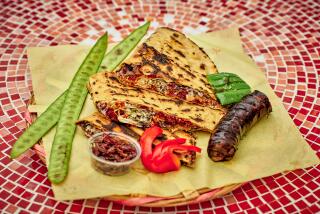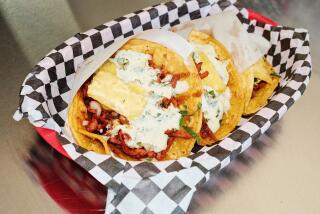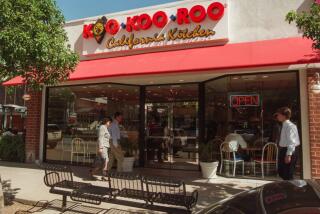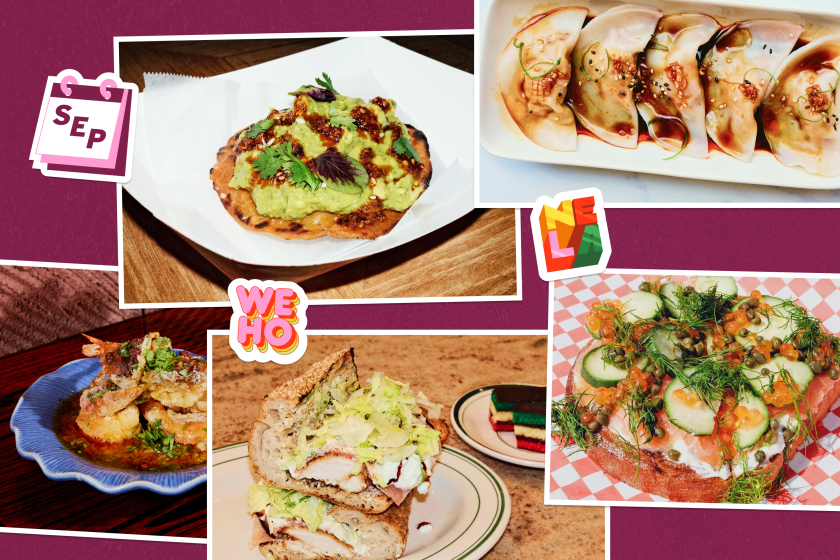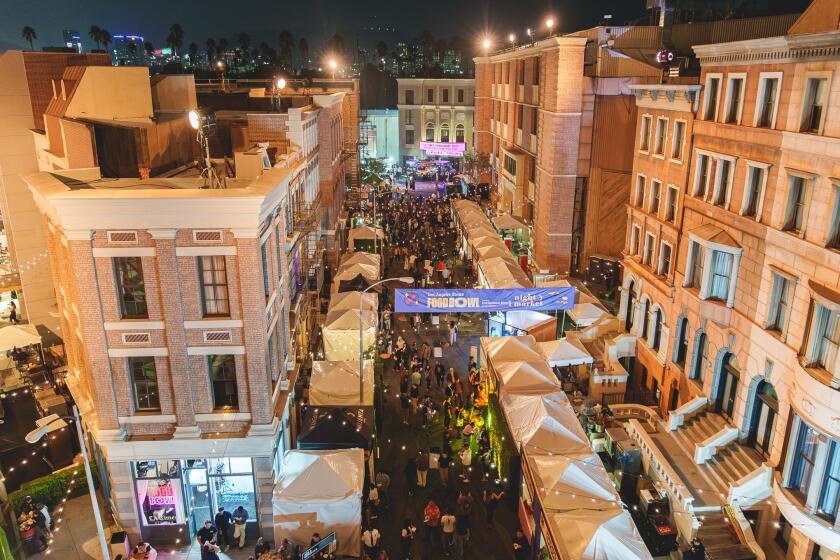The food trucks just keep rolling
On a typical Thursday night in downtown L.A., a $2 taco from the Kogi Roja truck will also cost you 45 minutes of your life. As the 50-person line snakes through the courtyard of the Japanese American National Museum, a DJ spins a mix of reggae, hip-hop and ‘80s hits. Tourists pose for pictures in front of the Kogi logo while Twitter-addicted truck junkies, grooving to the beat, patiently wait. Some people show up too late to get a taco at all.
Only one block away, it’s an entirely different story. The Calbi BBQ truck, a blatant Kogi imitator, dishes out its own version of fusion tacos: Korean-style barbecued meat heaped into mini corn tortillas. There are no lines, no crowds. Calbi is just a food truck; Kogi is a scene.
Striving for that seemingly effortless aura of cool, but always seeming to fall just short, Calbi is Skippy to Kogi’s Alex P. Keaton. And Calbi is not alone.
Choices, choices
In the aftermath of Kogi-mania, there has been a profusion of truck-borne food. The question is whether any of these other nouveau food trucks can capture that Kogi magic.
Today you can find food trucks offering hot dogs made from grass-fed organic beef (Let’s Be Frank); eco-friendly hamburgers, falafel and fish tacos (Green Truck on the Go); architecturally inspired ice cream sandwiches (Coolhaus); tonkatsu burgers on rice patties (Marked 5); sushi rolls (Fishlips Sushi); vegan sausages (the Franken Stand); all manner of “fusion” tacos (Kogi BBQ, Calbi BBQ, Bool BBQ, Don Chow Tacos); and coming soon, Vietnamese-style banh mi sandwiches (Nom Nom Truck).
Border Grill has its own taco truck, and even corporate behemoths like Taco Bell and Baja Fresh Mexican Grill are trying to cash in on the trend (the latter with “Baja Kogi” tacos).
In cities across America, new trucks, selling everything from clam chowder to cupcakes, seem to roll out every week.
The comparatively low cost of launching a truck as opposed to a restaurant has fueled the trend. John Bowler, owner and pit master of Barbie’s Q, as well as an experienced restaurateur and former mayor of Hermosa Beach, estimates that it cost him about $40,000 to start his pan-regional barbecue truck instead of the $200,000 he would have needed to open a restaurant.
The biggest chunk of that was his truck, which comes with the standard-issue griddle, steam line, warming oven, refrigeration unit and deep fryer. New, a standard street food truck typically costs $100,000 to $140,000, and it can be customized to just about any specs.
Rather than buying trucks, most vendors lease, and many of them, including Bowler, lease from Road Stoves, a downtown L.A. truck yard and commissary that also rents to Kogi BBQ, Green Truck on the Go, Marked 5 and several others.
While Kogi seems to turn a tidy profit vending on the street, many other trucks have to rely on catering and private events to pay the bills.
“We’re getting a lot of companies that want us to come in and serve lunch once a week or once a month, which is where we’ll probably end up. And then all of this,” says Bowler, gesturing to Abbot Kinney Boulevard, where he’s parked on a typical Thursday night, “will be gravy.” He estimates that 40% of his business already comes from private catered events, and he expects that figure to rise.
There hasn’t been a food trend this hyped since Pinkberry and its imitators began mushrooming in vacant strip mall storefronts. The unglamorous coda to the fro-yo boom of 2007 is that a sour economy and a saturated market have forced several local shops to close, while Pinkberry and Red Mango rein in expansion plans.
And with so many nouveau food trucks targeting the same diners at many of the same events and locations -- art walks, festivals, concerts and bars -- there’s bound to be attrition.
On the other hand, despite being hyped to the heavens, these decidedly experimental -- and often expensive -- nouveau food trucks may be more than just an emblem of culinary fusion or a clever use of social networking technologies. They may actually herald a significant change in the mobility patterns of young, middle-class urbanites known as “millennials.”
“I think the vending phenomenon is the product of a whole new lifestyle,” says James Rojas, founder and co-chairman of the Latino Urban Forum and a transportation planner for L.A. County’s MTA.
“Traditionally, taco trucks were very working class -- janitors, secretaries, people on public transit -- but now they’ve been adopted by the middle class as a legitimate way to buy and sell food,” Rojas says. “I think people under 30 want to bike and walk and take transit. These aren’t Latinos that have to take transit. These are privileged, middle-class kids. So taco trucks are targeting this group.”
Taco truck territory
Many Los Angeles neighborhoods have a well-established street food tradition with roving vendors who sell corn, tamales, paletas, gelados and champurrado. The thing they lack is any eliteness, the sense of being among an inner-circle of foodies, which the use of Twitter breeds.
“Traditional taco trucks park in the same spot, and you can count on them to be there,” says local food blogger Hiu Chung So of L.A. and O.C. Foodventures. “[These new trucks] have this exclusivity because you have to be in the know.” The cachet of eating at a hot new food truck may have as much appeal as the food itself.
Traditional and nouveau food trucks may target different demographics, but the cultural crossover goes both ways.
Guadalupe Ariza, who owns and runs the Tacos Arizas truck with her husband, Brigido, says that during the four years they’ve been vending in Echo Park, business has changed. “When I started, my clientele was mainly Latino,” Ariza says. “Now it’s all kinds of people: East Indians, Asians, white people. I’ve also been seeing Americans, who never used to order lengua, tripa and cabeza, ordering these meats more often.”
More to Read
Eat your way across L.A.
Get our weekly Tasting Notes newsletter for reviews, news and more.
You may occasionally receive promotional content from the Los Angeles Times.
